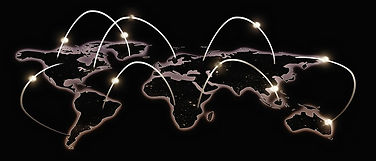

The Digital
Navigator
AI and the Intelligent Network
Photo: AI Generated
AI and the Intelligent Network
International business has been transformed by the power of instantaneous communication. The combination of computer and telecommunications has collapsed the time and distance factors that once separated nations, people, and business organizations. This chapter will examine the subject
of intelligent networking, which provides the technology and electronic pathways that makes global communication possible for small and large organizations alike. We start with the premise that the intelligent network is not one network but a series of networks designed to enhance worldwide communication for business and residential users. What gives the network its unique intelligence are the people and users of the system and the value-added contributions they bring to the system via critical gateway points. We begin by asking the following question. What makes an intelligent network intelligent? Specifically, what are the defining characteristics and features that comprise so-called intelligent networks? Intelligence can be defined as the ability to reason, problem solve, think abstractly, comprehend complex ideas, and learn. Halal (1997) describes organizational intelligence as the “capacity of an organization to create knowledge and use it to strategically plan and adapt to its environment.”
Four Working Assumptions about Intelligent Networks
When engineers discuss the architecture of a network, they are describing how the physical parts of the network are organized, including: 1) Information Pathways (network configurations), 2) Terminals (computers, smartphones, etc.), 3) Software (applications and protocols), and
4) Data Enhancement Equipment (modems, laser printers, Wi-Wi, etc.).
First, as noted earlier, the intelligent network is not one network but a series of networks designed to enhance worldwide communication for business and individual users alike. Second, what gives the network its unique intelligence are the people and users of the system and the value-added contributions they bring via critical gateway points. Today, the Internet has grown exponentially in size and complexity due to the many contributions of its users, ranging from powerful search engines to unique Web site design as well as the aggregation of content.
A third assumption is that intelligent networks do not operate in a vacuum. Rather, the use of intelligent networks are part of a greater human communication and organizational decision-making process. Nowhere is this more evident than in the creation of enterprise resource planning (ERP) and just-in-time manufacturing (networks designed to aid business process). And fourth, as intelligent networks grow and evolve, they become smarter over time in what can be described as self-learning. This is a crucial element in helping to explain the power of artificial intelligence.
Photos: Pixabay
Suggested Readings, Journals and Websites
Carah, N. (2021). Media and Society: Power, Platforms, and Participation.
Thousand Oaks, CA. USA: Sage.
Poell, T., Nieborg, D. & Duffy, B. (2021). Platforms and Cultural Production.
New York, USA: John Wiley & Sons.
Schmidt, E. & Cohen, J. (2013). The New Digital Age. New York: Alfred A. Knopf.
Suggested Video Presentations
History of Steve Jobs
https://www.youtube.com/watch?v=s4pVFLUlx8g

